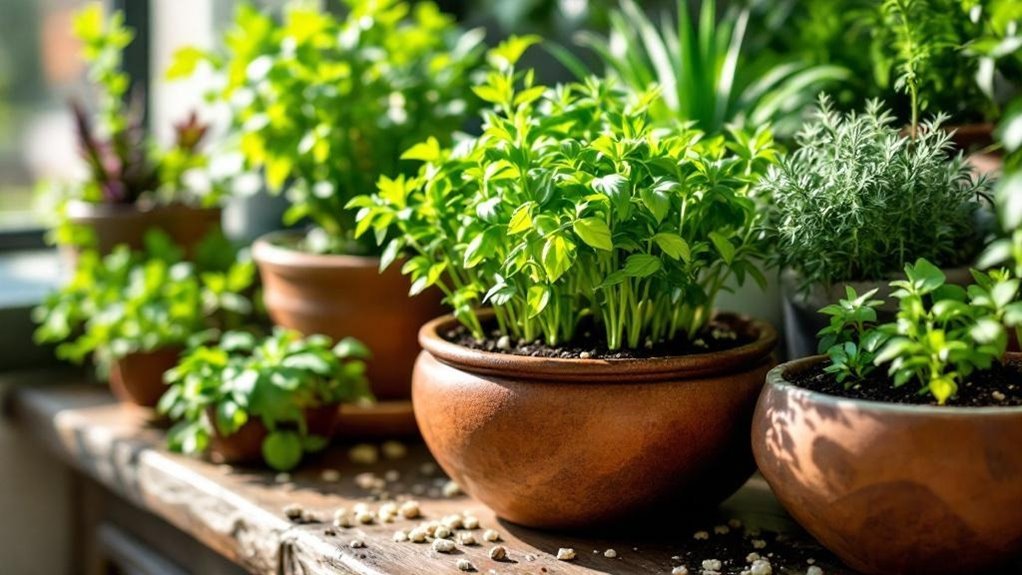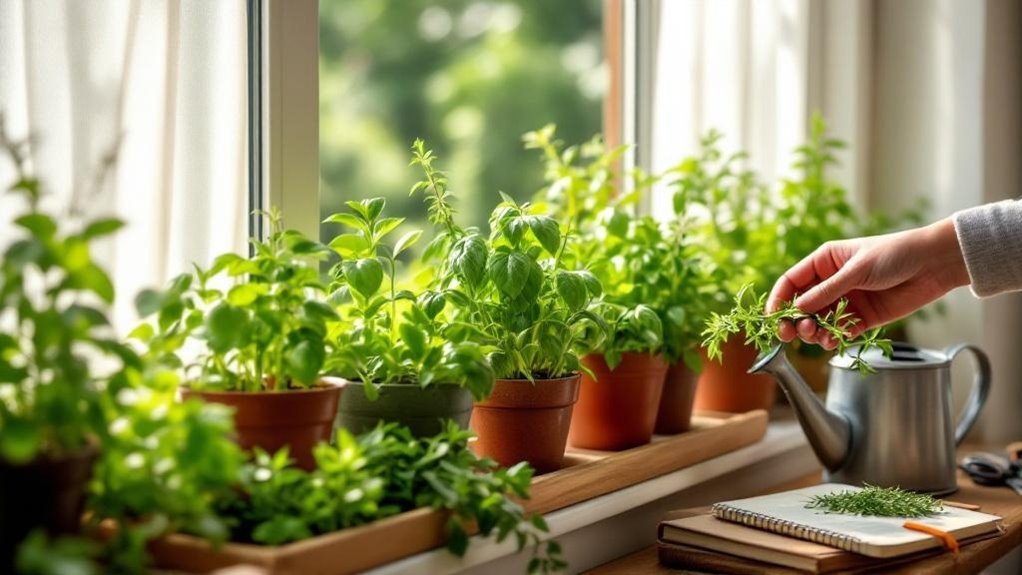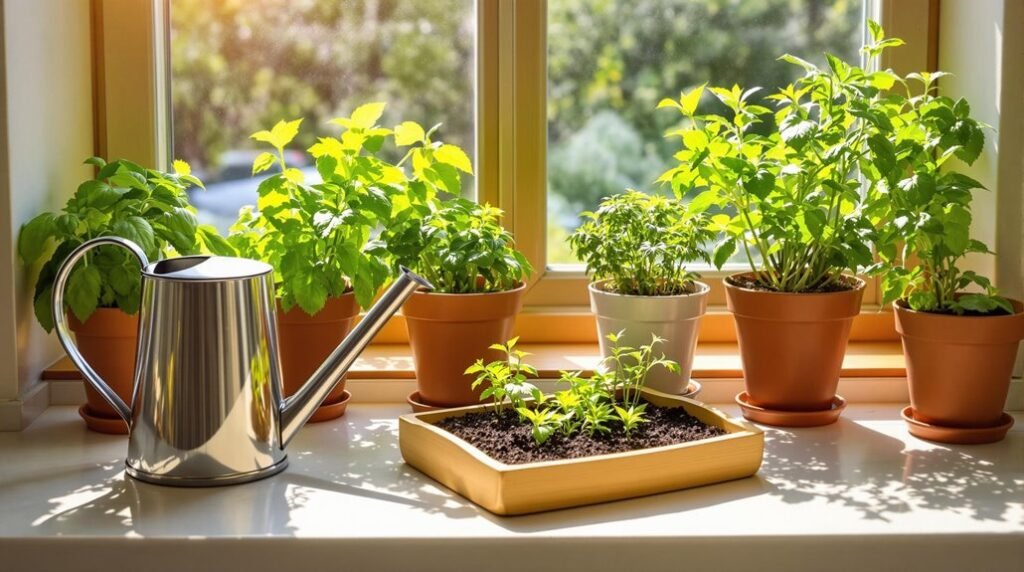Growing herbs indoors year-round can seem tricky, but with the right approach, you’ll enjoy fresh flavors no matter the season. You’ll need to pick herbs suited to indoor life, figure out the best lighting and temperature, and handle watering carefully. Plus, choosing the right containers and soil plays a big role. There’s more to it than just planting seeds, and getting these details right can make all the difference.
Choosing the Best Herbs for Indoor Cultivation
When selecting herbs for indoor cultivation, focus on varieties with shallow roots and adaptability to limited light, like winter savory, ‘Berggarten’ sage, mint, and oregano.
These herbs grow well indoors and suit the light requirements of most indoor spaces. For culinary use, annuals like basil and parsley offer quick growth, while perennials such as chives and thyme provide a regular harvest over time.
To maintain ideal conditions, avoid overcrowding; plant mint separately to prevent its aggressive spread. Understanding each herb’s light needs helps you choose the best herbs for your environment—south or west-facing windows suit full sun lovers, while east-facing windows are better for partial sun herbs.
Providing Ideal Light and Temperature Conditions
Although herbs can adapt to varying indoor environments, providing them with the right light and temperature conditions is crucial for healthy growth.
Most herbs need at least 4-6 hours of bright indirect sunlight daily, ideally from east- or west-facing windows. South-facing windows suit full sun herbs like rosemary and basil. If your indoor herb garden isn’t getting enough light, you’ll notice leggy growth and pale leaves—signs you should supplement with grow lights or artificial light, especially during winter.
Keep nighttime temperatures between 50°F and 60°F to promote healthy plants and reduce pests. Also, avoid placing herbs directly against cold glass to prevent frost damage.
Selecting Suitable Containers and Soil Mixes

Since healthy roots form the foundation of thriving indoor herbs, selecting the right containers and soil mixes is vital.
Choose containers at least 6 inches deep with drainage holes to prevent excess water from pooling, which can harm a healthy root system. Opt for deep, wide pots to support proper root development and avoid overcrowding, giving your herbs enough space to grow.
Use an organic potting mix enriched with compost to supply fundamental nutrients, ensuring your herbs receive what they need. Avoid over-potting by selecting a pot size that fits the root ball snugly, preventing your plants from “swimming” in soil.
For effective moisture management, use saucers or liners to catch excess water, and pick container materials like plastic or metal that help maintain proper humidity levels. Additionally, consider open bottom designs for containers to enhance drainage and air circulation, promoting a healthier root environment for your herbs.
Watering Practices and Nutrient Management
To keep your indoor herbs thriving, you’ll want to water them only when the top 1-2 inches of soil feel dry, which helps prevent overwatering and root rot.
Using a well-draining potting mix and pots with drainage holes is crucial in herb cultivation to avoid waterlogging and support healthy root systems.
Monitoring soil moisture with a moisture reader can guide your watering practices, ensuring your herbs get just the right amount of hydration. Additionally, utilizing a 3-in-1 soil pH meter can provide insights into moisture levels, pH balance, and sunlight intensity for optimal herb growth.
For nutrient management, apply a diluted indoor plant fertilizer starting in spring and twice during summer. This plant food encourages healthy growth without overwhelming your herbs.
Avoid fertilizing in winter, as most herbs rest during this period.
Effective Harvesting and Maintenance Techniques

Proper watering and nutrient management set the stage for healthy herb growth, but how you harvest and maintain your plants plays a big role in keeping them productive.
To promote robust herbs, regularly harvest leaves by clipping outer branches just above leaf nodes. This encourages branching and fuller growth while enhancing flavor. Always use clean pruners to avoid spreading pests or diseases.
When harvesting, avoid cutting more than one-third of the plant at once to maintain health. Monitor soil moisture by checking that the top 1-2 inches are dry before watering, ensuring ideal growth conditions.
Keep maintenance low by trimming leggy growth and regularly checking for pests. These effective harvesting and maintenance techniques help your indoor herbs thrive year round. Additionally, using high-quality garden shears can significantly improve the quality of your cuts, promoting healthier plant growth.
Frequently Asked Questions
Can I Grow Herbs Indoors All Year Round?
You can definitely grow herbs indoors all year round. Just make sure you give them enough light, maintain proper temperature, use well-draining soil, and harvest regularly to keep them healthy and thriving continuously.
How to Have Herbs All Year Round?
Think of your herbs as little green suns; you’ll keep them thriving by giving 4-6 hours of light, watering wisely, harvesting regularly, and maintaining cozy temperatures. That way, you’ll enjoy fresh herbs all year round!
What Herbs Should Not Be Grown Indoors?
You shouldn’t grow rosemary indoors because it needs cool air and bright light. Sweet bay grows too slowly and needs space. Basil and summer savory struggle without strong light, so avoid them for reliable indoor growth.
What Is the Easiest Herb to Grow Indoors?
You’ll find basil so easy to grow indoors, it practically grows itself! Just give it 4–6 hours of sunlight, and watch it thrive. Mint and chives are close seconds, perfect for beginners like you.
Final Thoughts
Growing herbs indoors year-round is easier than you might think. By choosing hardy varieties like basil, parsley, and chives, giving them plenty of indirect light, and watering only when needed, you’ll keep them thriving. Remember, a stitch in time saves nine—regular harvesting and pest monitoring prevent problems before they start. With the right care, your indoor garden will flourish, filling your home with fresh flavors all year long.
